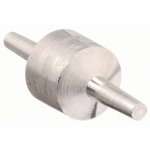210.4(B) states that each multiwire branch circuit shall be provided with a means that will simultaneously disconnect all ungrounded conductors at the point where the branch circuit originates. It is therefore NOT acceptable if a handle tie allows one ungrounded conductor to remain energized once the other one trips. If this happens the handle tie is not doing its job or the wrong kind is used.
Although I am doubting myself now and wondering if this is the case. I do know that they are flimsy and you might be right. I would appreciate some more education on this from others.
Oddly, I'd have to agree with you on this.
If the handle tie doesn't trip both breakers on a short or an overload then it's not practical to expect it to simultaneously disconnect both when manually operating it.
If you see them tied together you yourself shut them off at the same time by the way you do it.
I see a handle tie as more of a visual device to let you know 2 breakers may be sharing a neutral.
Think about it, if one of the breakers tripped, there is nothing that would keep someone from removing the tie, resetting the one breaker, then re-installing the tie, without ever disturbing the other breaker.
You wouldnt be that fortunate trying to do that with a common trip breaker.
Too much worry is put into a simple handle tie anyway as far as I'm concerned.
Just my 2 cents worth.
Jap>

